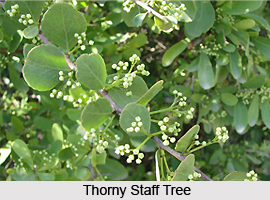 Thorny staff tree holds the botanical name Maytenus senegalensis (Lam.) Exell. This plant is well known in different names in different states and places in India and among the tribes of India. This medicinal plant holds the name `Vaichigachha` in Bengali, ` Vikalo` in Gujarati, `Thorny staff tree` in English, `Tandraja` in Kannada, `Bharati` in Marathi, `Kosai` in Oriya, `Kharai` in Punjabi, `Kattanji` in Tamil and `Danti` in Telugu.
Thorny staff tree holds the botanical name Maytenus senegalensis (Lam.) Exell. This plant is well known in different names in different states and places in India and among the tribes of India. This medicinal plant holds the name `Vaichigachha` in Bengali, ` Vikalo` in Gujarati, `Thorny staff tree` in English, `Tandraja` in Kannada, `Bharati` in Marathi, `Kosai` in Oriya, `Kharai` in Punjabi, `Kattanji` in Tamil and `Danti` in Telugu.
Thorny staff tree generally grows in dry regions throughout nearly all the Old World tropical and sub tropical areas of India. Besides its popularity in India, this medicinal tree also grows in outside India. In the dry scrub forests throughout India, particularly on poor soils in central and western peninsular India, this plant is seen in profusion.
Thorny staff tree is a much branched, spiny or unarmed shrub or small tree, usually are evergreen. The leaves of the tree are variable in size and shape, obovate to oblanceolate or elliptic, 2.5cm to 8cm long and 1.5cm to 4cm wide, usually rounded or emarginate at apex, margins are entire or crenulate, base is rounded or obtuse and subcoriaceous. The petioles are 0.3cm to 1cm long.
The flowers generally blossom sporadically throughout the year. The flowering reaches in the acme from October and December and fruits come out between January and April in peninsular India. Flowers are small and white in colour. They generally bore in axillary cymes. The pedicels are filiform, jointed below the middle and 3.5 mm to 5 mm long. The bracts are small, lanceolate and acute. The calyx lobes are broadly elliptic oblong, rounded at the apex and ciliate. The petals are 3 mm long and are elliptic oblong.
Fruits are broadly obovoid or subglobose, 10-12 mm long and 8-9 mm in diameter, purplish or black when the fruits get ripe and are three celled. The seeds are ovoid or ellipsoid, 2.5mm to 3.5mm long and tinted in red with a fleshy aril.
The entire Thorny staff tree is of great value according to the practitioners of medicine. Ayurveda considers the sour, sweet and acrid fruits of Thorny staff tree are considered to be digestible, stomachic, cooling and blood purifying. The fruits are extremely useful for the treatment of biliousness, ulcers, piles, thirst and corneal opacities. The bark is ground to a paste and applied with mustard oil to kill head lice.
The rural inhabitants of Bhavnagar District in Gujarat chew the leaves of Thorny staff tree or make a juice of the leaves for treating jaundice and other liver disorders. The leaves of the tree is crushed with those of Datura metel (Solanaceae), are reportedly used as an external application to tumours associated with plague among the Rabaris in the Barda Hills of Gujarat. The leaves of the tree are dried and pulverized and is ingested with milk as a medication capable of causing the evacuation of parasitic intestinal worms. A decoction of the leafy twigs is used as a mouthwash to relieve toothache. Even in other countries, the parts of Thorny tree are used for treating various diseases.











